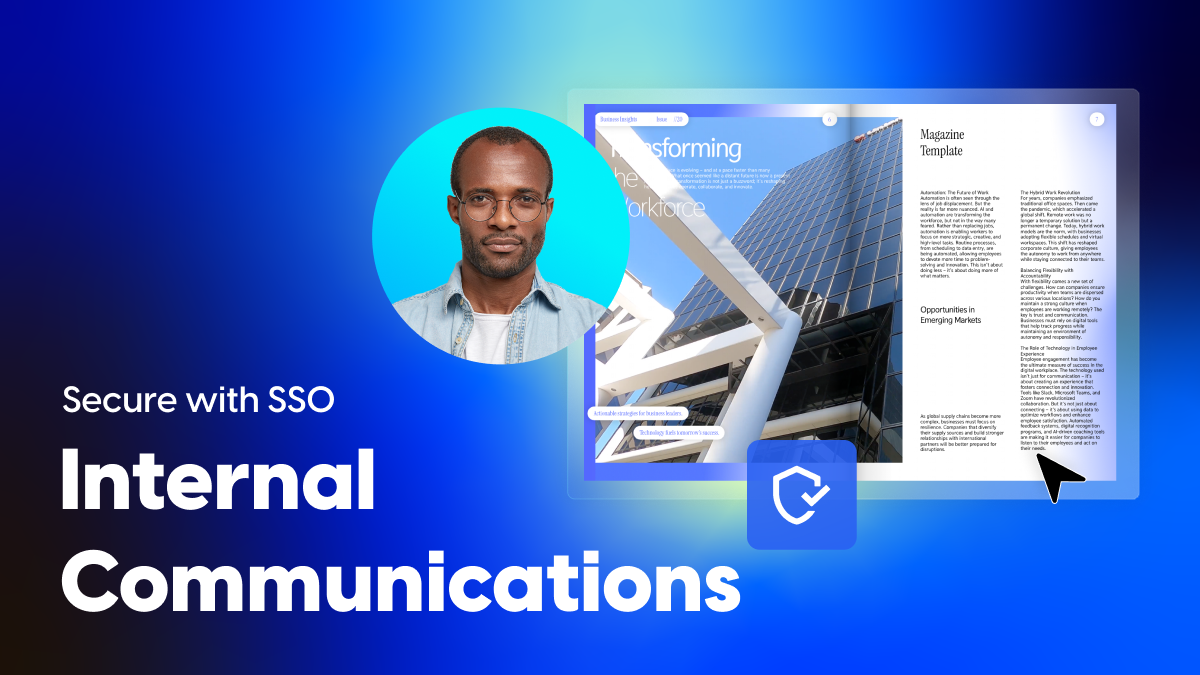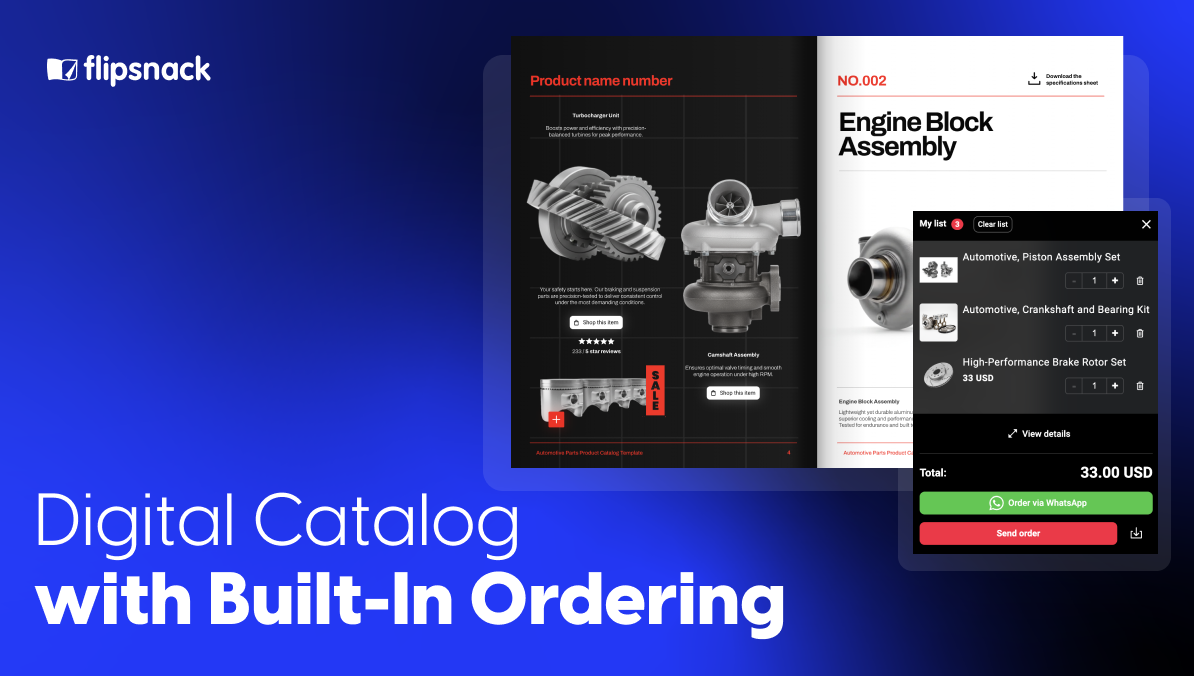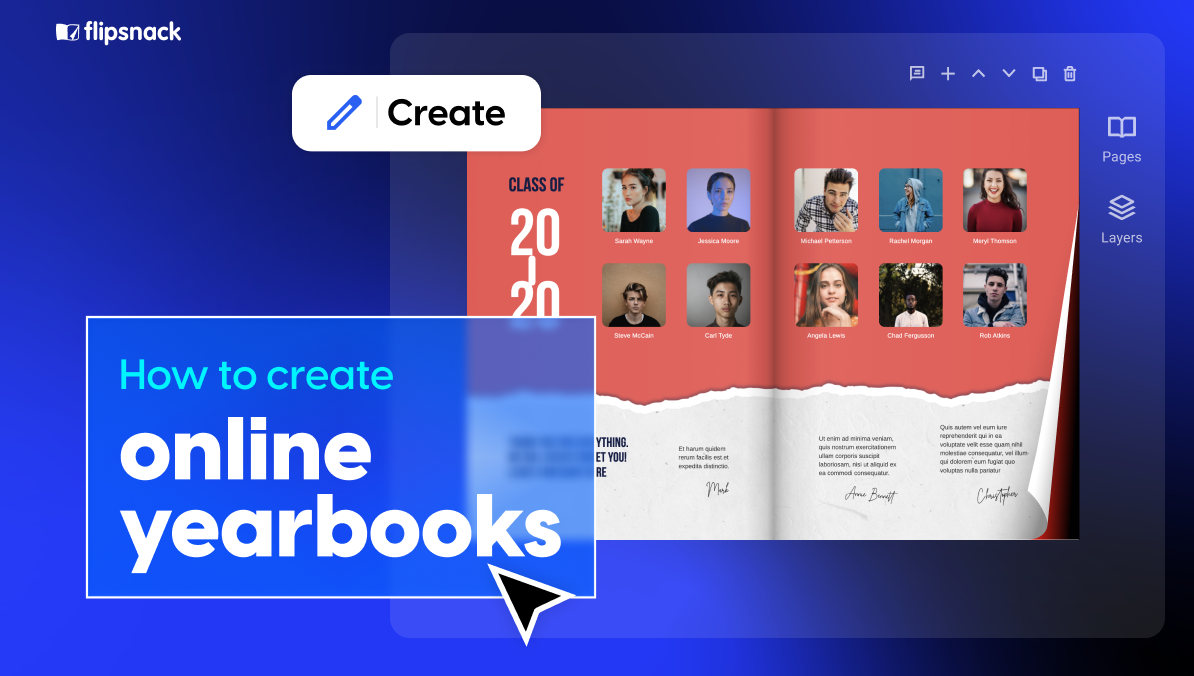Secure Internal Communications with SSO: How To Protect Your Company’s Content
In large organizations, internal documents, ranging from company handbooks and policy manuals to newsletters and training guides, often contain sensitive information intended only for employees’ eyes. Yet conveniently distributing these materials while keeping them secure is a constant challenge. You might worry that an internal PDF emailed to thousands could be forwarded externally, or that an intranet link could leak.
In fact, many enterprises struggle with exactly this balancing act, often forced to choose between security and usability. The good news is that with the right tools, you don’t have to compromise. This article examines why internal communications with Single Sign-On (SSO) have become crucial and how companies utilize Flipsnack, an interactive document-sharing platform, to maintain both the security and accessibility of internal content.
What’s at stake? Imagine needing to share an updated HR handbook or a monthly company magazine with thousands of employees.
Traditional methods can be time-consuming and risky. Some organizations set up individual accounts for every employee just to access documents, an administrative nightmare rife with endless password resets. Others resort to unsecured shared links or email attachments, which keep IT security teams up at night.
Even VPN-restricted networks can frustrate users with slow, complex access. These approaches often result in content being “all over the place” and hard to control, as one of our banking clients lamented.
Clearly, a more organized, compliant, and controlled way to publish internal materials is needed, one that ensures only the right people can access content and that everything stays on brand and up to date.

Real-World Use Cases Across Industries
Let’s look at how several organizations have used Flipsnack and SSO to secure their internal communications:
Provident Bank – Financial Services
This regional bank uses Flipsnack to securely distribute internal communication materials – think monthly newsletters, employee playbooks, and corporate policy guides to approximately 2,000 staff members.
Security was paramount: Provident integrated Flipsnack with their Azure Active Directory SSO, ensuring that only employees using their company credentials could open these documents. If a link to a flipbook somehow leaked, it wouldn’t matter – without an authenticated bank login, the content stays locked. Provident Bank also embedded many of these flipbooks into their SharePoint-based intranet, taking advantage of domain restriction so that the content cannot be accessed outside their internal SharePoint pages.
An added benefit for them was Flipsnack’s version control and single-link update: they can continually update a document (e.g., an HR policy) and keep the same link, so employees always see the latest version. They also track viewer-level analytics on these internal documents, helping them ensure compliance (e.g., confirming that all staff read a new policy) and gauge engagement with their communications.
Aecon Group – Construction
Aecon, a large construction company, needed a modern way to share a digital employee handbook and training materials with crews out in the field. Workers on job sites often only have tablets or smartphones, not laptops, so the solution had to be mobile-friendly and always up-to-date. Using Flipsnack, Aecon created a fully branded, interactive handbook (with a table of contents, search function, and even embedded videos for safety training).
They secured it by enabling SSO access for all employees, meaning an engineer on site can instantly pull up the latest policies on her phone by logging in with her company credentials. No one outside the company can access the handbook, and it won’t show up on Google searches or any public channel. Aecon was also able to create separate versions of the handbook for different regions (U.S. vs Canada) while maintaining the same high security standards. Because Flipsnack is easy to use (even for non-designers), Aecon’s team can update information or add new sections without technical help, and changes go live to all employees immediately (with the same link).
The result is a centralized, secure knowledge hub that field employees can rely on, and management can trust that only employees can see it.
Insurance Services
A national insurance provider’s communications team manages thousands of documents, especially employee benefit guides and client‑facing material,s and their previous solution struggled at this scale. They adopted Flipsnack for a more secure, scalable approach.
A key win was granular user management: the team created multiple workspaces and folders organized by client, region, and office, and applied role‑based permissions so each user (employee or client stakeholder) sees only relevant content. With Single Sign‑On (SSO), employees log in using corporate credentials, simplifying onboarding and authentication.
For client sharing, the firm uses secure links and, when needed, optional password protection. They also replaced a clunky Google Analytics setup with Flipsnack’s built‑in analytics and reporting, making it easy to show each client how their employees engage with materials. In short, Flipsnack delivered stronger content security and easier collaboration, critical for an insurance organization handling sensitive data across many teams and accounts.
These examples span very different industries: finance, construction, and insurance, yet a common theme shows.
Organizations with sensitive internal content all demand a secure, controlled sharing method, and they found success with SSO + Flipsnack as the solution. Whether it’s keeping an internal newsletter confidential within a bank or ensuring only your employees can access the latest design playbooks for a beloved gaming franchise, the combination of Flipsnack’s platform with Single Sign-On access control has proven effective.
The challenge of securing internal communications
Internal communications teams face a dual challenge: disseminating information quickly to employees while preventing it from reaching unauthorized parties. This is precisely where Flipsnack helps. By transforming static PDFs into interactive, secure flipbooks with Single Sign-On (SSO), domain restrictions, and real-time updates, Flipsnack ensures that sensitive materials from handbooks to newsletters always reach only the right people, in their latest version, under strict compliance controls.
A few common pain points include:
- Account overload: Setting up and managing separate logins for each employee or stakeholder. This consumes IT hours and leads to “endless password reset requests.” It’s not scalable when you have hundreds or thousands of readers.
- Unsecured links: Relying on open links (e.g., a PDF on a shared drive or a generic link) that can be forwarded or discovered by unauthorized people. This risks leaks of confidential information if the link escapes your organization’s confines.
- Outdated versions and update chaos: Even when teams manage to share documents securely, ensuring employees always have the latest version is another headache. Sending updated PDFs by email or uploading new versions to multiple platforms often leaves staff referencing old, outdated files. This can cause compliance risks and inconsistent messaging.
- Cumbersome access: Using complex solutions like VPNs or manual email attachments makes accessing documents slow and frustrating. When accessing a simple policy update becomes a hassle, employees are less likely to engage with the content.
- Multiple platforms and processes: Juggling various tools (email, SharePoint, file servers) and inconsistent security protocols for different documents. This patchwork approach can leave gaps in security and make it hard to track who has seen what.
All these issues boil down to a tough trade-off: ensuring robust security versus providing a smooth user experience. Too much friction and employees won’t read the materials; too little control and sensitive content might slip out. What’s needed is a way to deliver internal content that is easy for authorized users yet sealed off from everyone else.
How Single Sign-On (SSO) improves security
SSO allows employees to access multiple applications or services (like an internal documents portal) using their existing company credentials. In practice, it means an employee can click a link to an internal document and be automatically authenticated via your company’s identity provider (e.g., Azure AD, Okta, Google Workspace) no separate username or password needed. Once verified, they gain instant access to the content.
Why does SSO make internal communications more secure and user-friendly?
Consider these key benefits:
- Authenticated access only: Every viewer must be an active employee (or in your SSO user directory) to open the document. If someone leaves the company or loses access, their SSO deactivation automatically revokes their document access. This ensures that only current authorized staff can view internal content, and access is cut off the moment it should be.
- No shared credentials or links: Employees use their normal corporate login – there’s no need for generic passwords or public links that could be leaked. This eliminates unsecured link sharing and prevents unauthorized viewers from ever reaching the content in the first place.
- Centralized security policies: SSO ties document access to your central identity management. You maintain a single point of control with consistent security policies (like multi-factor authentication, conditional access rules, etc.) across all tools. There’s no need to manage separate accounts, so administrative overhead drops dramatically.
- Detailed audit trails: Because access flows through the SSO system, every login and document view can be logged. Flipsnack, for instance, tracks each interaction – giving you individual-level analytics on who opened a document and what they did with it. You get time-stamped records and can even export logs for compliance reporting.
- Seamless user experience: Crucially, SSO improves security without hurting usability. There are no extra passwords for employees to remember or accounts to create. An authorized staff member clicks the link, and within seconds, the document opens in their browser. This frictionless access means employees are more likely to engage with the content, boosting the reach of your internal communications.
In short, SSO provides enterprise-grade security by leveraging your existing authentication infrastructure, while making access effortless for your team. It’s the best of both worlds: IT gets peace of mind that internal documents are locked down, and employees get a convenient, one-click reading experience.
Flipsnack for a secure internal communications platform
Having the right platform in place is just as important as the SSO technology itself. Flipsnack is a digital publishing and document-sharing platform that many enterprises use for internal communications because it offers robust security features built in. Flipsnack essentially turns static PDFs into interactive flipbook-style documents – but crucially, it does so in a controlled, secure environment designed for internal use.
Some of the ways Flipsnack helps companies lock down their internal content include:
SSO Integration for viewers
Flipsnack supports modern SSO protocols (SAML 2.0, OAuth, etc.) and easily connects to providers like Okta, Microsoft Azure AD, Google, OneLogin, and others. This means you can enable SSO-only access for your flipbooks – employees will simply use their company SSO login to view documents, and you can even disable all other login methods to enforce SSO exclusivity. No Flipsnack-specific accounts are needed for your viewers at all.
Private sharing & access control
For more granular control, Flipsnack allows you to mark documents as private and invite specific individuals or groups by email, or even assign content to “workspace readers.” You can mix and match, for instance, use SSO to broadly gate content to employees, and within that, assign certain documents only to particular departments or teams.
The platform’s role-based permissions ensure employees only see what they should, preventing cross-department snooping.
Domain restriction for embeds
Many companies embed Flipsnack flipbooks on their intranet pages or SharePoint sites for easy internal access. Flipsnack’s domain restriction makes sure that your flipbook can only be viewed when embedded on authorized domains (like your intranet) and nowhere else. Even if someone somehow got the embed code or link, it wouldn’t work on an unauthorized site. This prevents any chance of your internal documents being posted on public websites – a vital safeguard for keeping private or sensitive information secure.
Secure infrastructure & compliance
Flipsnack takes enterprise security seriously. Data is transferred and stored encrypted, and the platform offers compliance measures for industries with strict regulations. (For example, Flipsnack can help companies remain HIPAA compliant when sharing sensitive documents.)
Therese H. Lindeløv, Creative Content Manager, Global Product
Tracking and analytics
Unlike sending a PDF attachment, where you have no idea who read it, Flipsnack provides detailed statistics for each document. You can measure impressions, clicks, average reading time, and even see individual reading activity. This means internal comms teams can verify whether employees actually read that new policy update or newsletter. It closes the loop on communication: not only is the content secure, but you also have insight into engagement and can follow up accordingly.
Results: Secure communication without compromise
The value of implementing SSO for internal communications is undeniable: organizations can protect sensitive information while making it simple and efficient for employees to access what they need. Many companies using Flipsnack with SSO have not only tightened their security but also seen a boost in employee engagement, thanks to the seamless, one-click access experience. Far from creating barriers, stronger security has actually unlocked more effective communication by fostering trust and ease of use.

Today, safeguarding internal content isn’t just an IT responsibility; it’s a company-wide priority for HR, communications, and leadership alike. With Flipsnack and SSO, enterprises achieve the ideal balance: airtight control over who can access handbooks, policies, and newsletters, while employees enjoy an intuitive reading experience that requires no extra effort. The result? Communications that stay confidential, consistent, and impactful.
In an era of remote work and constant digital exchange, secure content distribution is an investment in organizational trust, efficiency, and culture. By adopting SSO-protected platforms like Flipsnack, companies ensure that knowledge flows freely inside the business without risk of leaks or cumbersome access barriers. The outcome is a workforce that stays informed and confident, and an IT team that knows sensitive materials are locked down.
Secure, modern internal communication isn’t just possible; it starts with that simple, one-click SSO login to your next internal document.



